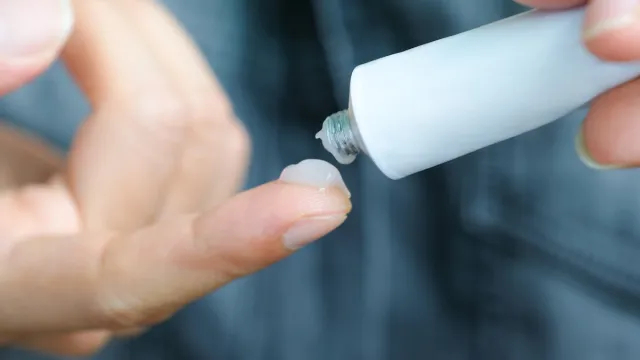FDA Says Certain Topical Pain Relievers “Should Not Be on the Market” in New Alert

Medicine cabinets are a catch-all for skincare essentials, antibiotics, and common pain relief products. But as you kick spring cleaning into high gear, there are certain topical pain relievers the U.S. Food and Drug Administration (FDA) is urging consumers to discard from their stockpile due to unlawfully high amounts of a potentially hazardous ingredient.
On March 26, the government agency issued a new warning for 19 over-the-counter (OTC) analgesic (pain relief) products that contain higher concentrations of lidocaine than what is federally allowed for non-prescription topical pain relief drugs. These products come in the form of gels, creams, and sprays, and are advertised as topical treatments for tattoos, piercings, laser hair removal, microdermabrasion, and other cosmetic procedures, the FDA explained.
RELATED: Drugs Like Tylenol May Alter Heart Function, Study Says—How Much Is Safe.
When used correctly, lidocaine-based topical products can control, relieve, and prevent pain and itching, according to Mayo Clinic. For those who have undergone more significant cosmetic procedures, the topical solution can cause “numbness or loss of feeling” near the affected area, they add.
However, when unregulated amounts of lidocaine are applied, you may be putting yourself at risk for serious health effects, including “irregular heartbeat, seizures and breathing difficulties,” per the FDA’s notice. Not to mention, they can have a negative interaction with other medications and dietary supplements.
This isn’t the first time the FDA has warned consumers about topical anesthetics made with lidocaine. In a 2009 advisory to both patients and healthcare professionals, the agency stressed that “if the topical anesthetic is applied over a large area of the skin, if a large amount is applied, if it is applied to irritated or broken skin, or if the skin temperature increases,” the likelihood of the medication passing into the bloodstream increases drastically. Once in the bloodstream, the OTC drug can cause comas or even death.
But even still, topical pain relievers with high concentrations of lidocaine still exist—and some may even be in your home. The FDA has distributed warning letters to TKTX Company, SeeNext Venture, Tattoo Numbing Cream Co., Painless Tattoo Co., Derma Source Inc., and INKEEZE, companies with products that violate federal law. A detailed list of each company’s illicit products can be found in the FDA’s release.
RELATED: FDA Issues New Warning on Hidden Dangers of OTC Pain Relievers: “Stop Right There.”
There have been several reports of adverse health effects in conjunction with these products, which the FDA has been made aware of. The FDA is asking those who have experienced serious side effects to report their case to the MedWatch Adverse Event Reporting Program.
“These products pose unacceptable risks to consumers and should not be on the market,” said Jill Furman, JD, director of the Office of Compliance in the FDA’s Center for Drug Evaluation and Research. “We are committed to using all available tools to stop the sale of these illegal high-risk products.”
Moving forward, the FDA is advising consumers to steer clear of OTC topical pain relievers that contain more than four percent of lidocaine. If you are using a lidocaine product, the agency asks that patients don’t apply amounts over large areas of skin or to irritated/broken skin. Lastly, refrain from wrapping treated areas with dressings as that may increase the chances of adverse health effects.
Best Life offers the most up-to-date information from top experts, new research, and health agencies, but our content is not meant to be a substitute for professional guidance. When it comes to the medication you’re taking or any other health questions you have, always consult your healthcare provider directly.
- Source: FDA Warns Consumers to Avoid Certain Topical Pain Relief Products Due to Potential for Dangerous Health Effects
- Source: Mayo Clinic: Lidocaine (Topical Application Route)
- Source: FDA: Potential Hazards of Skin Products Containing Numbing Ingredients for Relieving Pain from Mammography and Other Medical Tests and Conditions
- Source: FDA: MedWatch